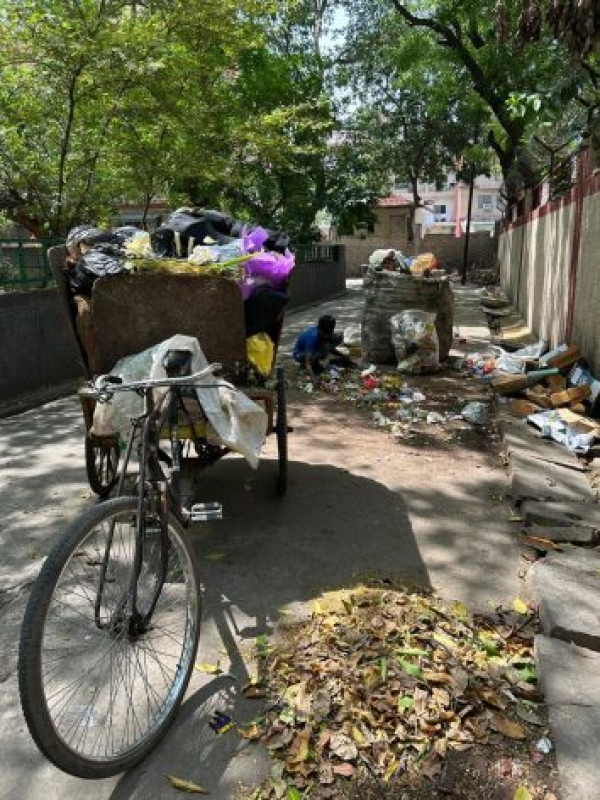- Khaleda Zia integral to an important chapter in BD history: Yunus |
- Enthusiasm marks Victory Day celebrations across Bangladesh |
- Dhaka-Delhi ties deep; to be shaped by trust, dignity, mutual respect |
- EU deploys election observation mission to Bangladesh |
Delhi’s Waste Pickers Need Buses, Not Just Climate Promises

Waste pickers in New Delhi are marginalised yet provide essential services, often in extreme heat. Credit: Aishwarya Bajpai/IPS
Every day, Delhi’s waste pickers walk three to four kilometres under the scorching sun, collecting and sorting the garbage that keeps India’s capital running. Their work is indispensable—but remains largely invisible.
An estimated 200,000 waste pickers operate in Delhi, most of them migrants from landless, rural families in northern and eastern India. Displaced by declining rural economies, they end up in the informal recycling sector—performing one of the city’s most essential jobs without contracts, legal protections, or public recognition.
“We’re often denied access to buses because people say we smell,” says Sheikh Akbar Ali, a veteran waste picker from Seemapuri. With a daily income of ₹300 (USD 3.60), even a one-way auto ride at ₹150 (USD 1.80) is a luxury. For women, conditions are worse: no toilets, no changing spaces, and no shelter from the sun.
COVID-19 made things harder. “Since the pandemic, we’ve been pushed off shaded areas and forced to work under the open sky,” he adds.
The Smart Cities Mission has made things worse by reducing accessible public spaces, replacing community corners with manicured zones and surveillance.
Sumit Chaddha, another waste picker in Kamla Nagar, recalls a time when they were allowed to stop work by 10 a.m. during summer. “Now, even in unbearable heat, we must keep working. One man collapsed from the heat—he vomited and died,” he says. “We don’t even get gloves, let alone health services or medical cards.”
In 2024, Delhi recorded a blistering 52.3°C, in what the World Meteorological Organization marked as the hottest year in 175 years. Delhi also remains among the world’s most polluted cities—with 74 of the 100 worst air quality cities located in India, according to the 2024 World Air Quality Report.
While public debate often blames stubble burning or firecrackers, analysis from the Centre for Science and Environment confirms vehicular emissions are the leading contributor.
The city breathes hazardous air nearly 99 percent of the time. PM2.5 levels—tiny particles that can lodge deep in lungs—exceed WHO safe limits by as much as 30 times. Even brief exposure can cause heart attacks, strokes, and respiratory failure.
For the poorest—already suffering from heat, hazardous work, and cramped living conditions—public transport is their only lifeline. Yet that system is in disarray. Over 100,000 bus breakdowns were reported in just the first nine months of 2024.
Globally, road transport accounts for 71% of emissions from the transport sector. India, now the third-largest CO₂ emitter, released 2.69 billion tons of fossil CO₂ in 2022—a 6.5% increase from the previous year.
Public transport could be the most direct, impactful climate solution—especially for the working poor. Environmental researcher Sumana Narayanan explains, “We treat public transport like charity. But mobility is a right—just like water, clean air, and health.”
She points to the success of Delhi’s fare-free bus scheme for women (launched in 2019), which gave women greater access to income, independence, and safety. “Public transport doesn’t just move people—it carries dignity, opportunity, and the right to be seen,” she adds.
Germany’s €49 climate ticket, Luxembourg’s free transport policy, Bogotá’s TransMilenio, and Paris’s investment in metro and cycle lanes show how transport can drive both climate resilience and social inclusion.
India, however, is lagging. The National Electric Bus Programme (NEBP) aims to roll out 50,000 electric buses by 2030, but implementation is slow and fragmented. Meanwhile, Delhi’s waste pickers continue walking miles under dangerous heat, breathing poisonous air, and risking their lives for the city’s cleanliness.
“We need long-term investment in quality and access,” says Nishant, Coordinator of Delhi’s Public Transport Forum. “Public transport is a great equaliser. It’s not just climate-friendly—it’s people-friendly.”
For Delhi’s waste pickers, a reliable bus isn’t a convenience. It’s a bridge to dignity, safety, and survival. In a city choking on inequality, extreme heat, and toxic air, climate justice might just begin with something as basic as a bus ride.

